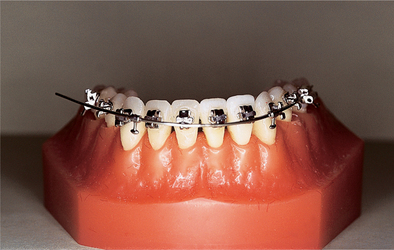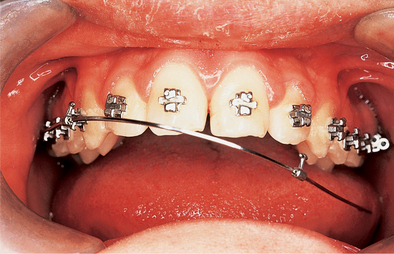CHAPTER 18 Stage III: fitting the archwires (and Side-Winders)
With the Plus bracket, the main archwires should only be fitted after the nickel–titanium uprighting wires have been placed in the deep tunnels. The rectangular wires should go in easily, so long as levelling and alignment has been satisfactorily maintained during the second stage. Resistance when attempting to enter the molar tubes is almost invariably due to failure to derotate the molars at the last Stage II adjustment.
Testing for molar torque
Before fitting the archwire, it is important to assess whether there is any torque discrepancy between the archwire and the buccal tubes. Any active torque thus found should be recorded in the patient’s notes. Just as with any edgewise-based appliance, the test is to insert the distal end of the archwire into the buccal tube on one side only, keeping clear of the brackets, and then observing the height of the free distal end on the opposite side, relative to its buccal tube (Fig. 18.1). Any height discrepancy at this point will denote the direction and extent of the torque discrepancy in the molar engaged. The same test should then be applied to the opposite first molar.
Should any torque discrepancy be apparent, this does not necessarily imply a fault requiring rectification. The temptation to adjust the torque in the buccal segment away from zero, to make it passive in the tube, should generally be resisted. More often than not, the archwire may be telling the orthodontist something about the molars. Have the mandibular molars inclined lingually, for instance? If so, a zero torque setting in the archwire will help to upright them. Figure 18.2 shows the engagement of an upper second molar in a first molar extraction case, in which the palatal cusp has dropped; again, this will be corrected automatically during the stage, without need for archwire adjustment. Sometimes when fitting the archwires, if there is a considerable torque discrepancy, it may be necessary to flex the archwire slightly about its long axis as it is being inserted (with a light wire or torquing plier) to help it slide freely into its buccal tube.
Stay updated, free dental videos. Join our Telegram channel

VIDEdental - Online dental courses




